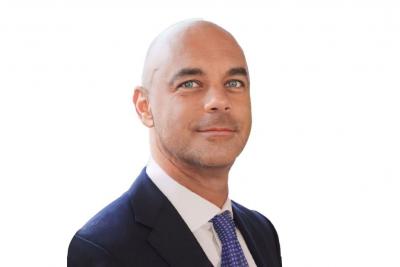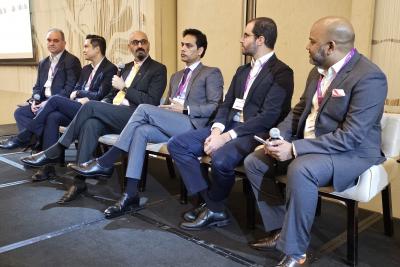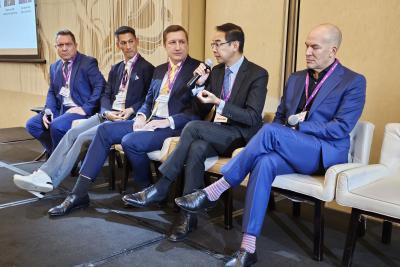Dragon Capital VietFund Management at the Cutting Edge of Expanding and Democratising Vietnam’s Financial Markets

Hanh Luong Thi My of Dragon Capital
Jul 9, 2021
Dragon Capital VietFund management (DCVFM) is an integrated investment platform focused on Vietnam. DCVFM as it is today is the result of the recent merger between two leading financial organisations – Dragon Capital and VietFund Management, and with Dragon dating back to 1994, the firm is now Vietnam’s longest-established independent asset management group with over USD5.3 billion of AUM. The firm focuses principally on listed equity and fixed income for international pension and sovereign wealth funds, endowments and family offices. DCVFM is committed to delivering robust, risk-managed returns on behalf of its investors, partners and stakeholders, and prides itself on being dedicated to improving corporate governance, contributing to society, and promoting sustainable development. Hubbis met with CMO Nick Ainsworth and with Hanh Luong Thi My, Head of Domestic Asset Management, who is responsible for product and business development and digital distribution, as well as fundraising. Together, they highlighted the opportunities in the relatively youthful capital and wealth markets in Vietnam, but they also articulated the realities – that they need support from the regulators, the government, foreign investors and fellow incumbent financial sector players to help drive the democratisation of investment across Vietnam’s vast population. An interesting area the firm has recently expanded into is the development of the private sector pensions industry, for which DCBVFM recently became the first license holder in the country, launching Vietnam’s very first defined contribution offering in April this year.
Hanh opens the conversation, reporting that Dragon Capital, first founded in 1994, had recently merged with VFM to create the new Dragon Capital VietFund Management (DCVFM), a firm that now boasts a total AUM of an impressive USD5.3 billion.
“We are the longest standing asset management company in Vietnam, having operated here for more than 27 years,” she reports. “The firm has been consistent throughout, helping drive the financial markets forward, helping to improve financial literacy, helping improve financial planning and develop a more advanced approach amongst investors as they strive to achieve financial independence and then to retire comfortably later on.”
Hanh herself has more than 17years of experience in investments and three years of experience in finance and auditing at KPMG. Hanh has been with VFM for 17years in a variety of roles. In 2005, she was appointed as Director of Portfolio Management of Vietnam Securities Investment Fund (VF1). In 2008, as Chief Investment Officer, she was responsible for building, structuring portfolio and planning effective investment strategies. In 2010, she was designated as Deputy CEO in charge of Investment and Research. And from 2021 onwards she become Head of Domestic Asset Management at DCVFM. She holds an MBA and is also a CFA charter holder.
The need to work in harmony
From her considerable experience of Vietnam’s financial markets, Hanh is enthusiastic about the immense potential ahead, especially as Vietnam stands on the cusp of moving from a frontier to an emerging market. She comments that the regulatory environment can be further developed to help encourage more bank distribution of mutual funds and therefore spread financial market democratisation in the country. And she says that digital distribution of investment products from digital platforms – one of her key responsibilities – is also helping develop the capital markets domestically, especially as Vietnam has a relatively young population which is very much tech-savvy.
She explains that the banks tend to focus more on insurance and insurance-linked investment products, as fees are attractive and penetration rates are higher than for mutual funds, which are more difficult to sell and where the penetration rate is less than 1% in Vietnam.
A rising tide of wealth and opportunity
“But therein lies the opportunity,” she reports, “as per capita incomes are rising, especially in the major cities, and with lower interest rates and greater understanding of financial products, better Relationship Managers (RM) and better skills, more people will take up funds as well as insurance-related products. So, the outlook for wealth management is encouraging.”
She explains that a key focus is therefore training RMs and training the distributors at the banks and other partners, helping them better appreciate the products, better handle the client understanding and risk profile, and offer greater suitability in terms of offering certain clients tailored, specific ideas and products.
“The growth profile ahead for the fund industry could be explosive,” she states, “assuming all the right elements combine to drive that growth. But of course, this growth is from an incredibly low base. Nevertheless, we think the next five years could see a major trigger point for the asset management industry.”
The drive to emulate growth in the regional wealth markets
Ainsworth, who first took up role at Dragon Capital some five years ago, has over 30 years of financial industry experience largely on the sell side at Morgan Stanley and always focused on Asia. He is encouraged by what he sees happening in Vietnam, and also realistic about the pace of the market’s evolution.
He adds his insights into the market and Dragon Capital’s position and missions, remarking that as Hanh had indicated, the market is in its relative infancy, and it is not an easy market for fund products, as people there are still very much wedded to inheritance, real estate, gold albeit perhaps less than before. “Disposable income is low, and if people want to save to buy a property, that takes a lot of their resources,” he explains. “So, it is a slow burn selling funds, a long-term process, and the start of that has to be investor education. But if we look across at what has happened in other regional markets, there are encouraging signs. China, for example, has gone rapidly from having no financial architecture at all to having thousands of funds, starting really only in the early 2000s. We can emulate that here with the right approaches from the government on tax, from the regulators to encourage more products and the right environment, and from the dedicated efforts of the financial sector incumbents and new entrants. But it will take time.”
Ainsworth explains that DCVFM focuses mainly on the mass affluent market. While the firm does focus on HNW and UHNW clients, he notes that at the higher end of the wealth spectrum, the HNW and UHNW community, both of which have been expanding apace, so many of those clients want to shift their investments outside Vietnam, in whatever ways possible. “But our firm does not at this stage offer investments outside of Vietnam,” he reports. “Our job is more centred on helping to bring money into Vietnam and building the local financial markets.”
If in the future, Vietnam opens up its capital controls, Dragon would certainly consider working with partners offshore to bring the right opportunities to the very wealthy clients in the country, but right now, this is not a real possibility from a regulatory perspective. “The very wealthiest investors here want to diversify internationally, that is for sure, but that is not within our remit at this stage,” he reports.
Wanted: more products and structures
Ainsworth for funds points to some areas where the domestic capital market can develop to help create more opportunities for the asset management business. He explains that the market is typically dominated by the buy and hold long-only type of investment strategy. But the initiation of the futures market and covered warrants in recent years have broadened trading opportunities. From here the stock lending business needs to be developed; there needs to be a domestic credit agency to help develop a more viable corporate bond market; there needs to be a deeper yield and credit curve developed from short to super-long dated paper, for example for project financing, and the market could benefit from the arrival of convertible bonds and other hybrids. “There is much to be achieved, and therein lies great potential, but it will be slow to evolve,” he observes.
ETFs and their role ahead
Another potential growth segment for Vietnam is in the world of ETFs, but at this stage, that is mainly dominated by foreign institutional investors using ETFs as a means to access what is an awkward domestic market to tap into for foreign investors.
“I think ETFs are somewhat misunderstood,” he comments.
“Many people think they are dominated by retail, but actually, most ETFs are funded by institutions. It is hard to think that's going to be different in Vietnam, but we need to offer people access to the market at a low rate, especially for those that don't have the confidence to invest in individual stocks, so an ETF is actually an ideal vehicle for retail investors here as well. We therefore have to familiarise people with the product, and with the risks. And then we need to find distribution, because we are a small company, we have 130 people, and Vietnam is a country of 100 million people, so we need partners to get these out into the market.”
Hanh agrees, noting that Dragon Capital started promoting ETFs around six years ago and has actually built AUM in the products of some USD1 billion, although the vast majority of that money is from offshore institutional investors, not locals. “We certainly see considerable potential in developing the ETF market here,” she confirms.
Key Priorities
Hanh addresses the question of the firm’s key priorities, reporting that education is the first mission. “Financial literacy is the key to moving this market forward,” she says. “People need to better understand the markets, the products, financial planning and the role of properly structured investing in delivering financial independence. And the second mission is to promote digitalisation to help more easily deliver the right products to investors who are increasingly used to access online or through smartphones, tablets and so forth. Vietnam is a young country demographically, and digital delivery and access can really help customers in investing and in achieving their longer-term financial goals.”
And the third priority is in the field of pensions. “There is an enormous opportunity here,” she reports. “So far, the insurance companies offer some kind of approximation to a lifetime savings strategy, but it's linked to insurance, the returns are not good, and it is expensive. But we are the first licensee to be providing provident funds, which is a great honour and a great challenge.”
She offers some more detail [see also box article below ‘Pensions in Vietnam – The Need and the Solutions’]. “Pensions will develop as an industry here if it is clear that both the individuals and the companies that benefit, for example, the latter achieving better ability to hire and retain talent,” she explains. “But to really boost the industry, we need tax breaks for both parties, although as yet the government doesn't want to put up an overly generous package upfront before they know whether it will be scalable or not.”
She reports that the regulations have, in fact, developed in the past couple of years, and the firm launched the country’s first defined contribution private pension product in April this year after becoming Vietnam’s first pensions license holder.
“There is huge potential, but it will be slow,” she reports, “because for the time being, the government allows an exemption of 1 million Vietnam Dong per month for individual contributions 3 million per month for companies to contribute tax-free, and both of those together amount to only about USD200 per month.” But something is better than nothing and, hopefully, the government will see the scalability and change these limits in the future.
Ainsworth agrees, adding that this is somewhat of a pathfinder mission and that the firm is working firstly with foreign FDI companies and also global companies who might have a global CSR commitment to providing pensions to their staff.
“These big accounting, banking, oil and other majors are globally committed to providing retirement services to their employees, so these are our first ports of call,” he reports. “It is admittedly a slow and laborious process because I think, as Hanh says, the benefits to the individual and to the company are not really significant yet, so some companies see it as a cost rather than a benefit. However, we see more companies realise that there are real benefits, and the tide will gradually turn, we believe. And for the individuals, this is a good development as private pensions represent long-term savings and low risks, albeit admittedly probably relatively modest returns - the packages are still rather restrictive; for example, equity is limited to 50% of the investments. But it is a start, a step in the right direction.”
Hanh adds that while the firm is currently making some headway selling to the companies, at the grassroots level, there has to be bottom-up education for the employees who need to be confident about putting their small savings each month into such pension programmes. “It is not so easy, but we are on the right path,” she says.
Grasping the potential
They close the conversation by reiterating the immense opportunities but also the great challenges ahead. Clearly, the pace of evolution in the financial markets in Vietnam is still lacking, and the regulator and the government need to do more to work in alignment with the private sector financial services providers to help oil the wheels and develop further impetus. “This firm has grown robustly over 27 years,” says Ainsworth, “but the potential ahead is really quite incredible in a country of 100 million people and with rapidly rising GDP, especially when we look at what neighbours such as Thailand, China and others have achieved.”
‘Pensions in Vietnam – The Need and the Solutions’
Nick Ainsworth recently penned a short report on the evolving pensions industry in Vietnam and the exciting potential for Dragon Capital as Vietnam's first ‘voluntary supplementary provident plan’ license holder, launching its first private pension offering in April in the form of the DCVFM defined contribution pension. Hubbis has summarised his insights as below.
“State plans or public pensions are still common worldwide but are not always universal and are frequently inadequate as contributions and performance have failed to keep up with the demands on these funds. This is the status of the VSSF or Vietnam Social Security Fund in Vietnam. More recently, workers have needed to contribute themselves along with their employers in the private sector, and the defined benefit pension has largely given way to the defined contribution pension.
This places responsibility on the individual to opt-in to the pension system and to pay in a part of their monthly salary over their working life: the employer pays in too, and there are some tax benefits both to the individual and to the company in this kind of system which will vary from country to country.
While the demographics of Vietnam are currently favourable - by 2050 or so, the over-60s will be an important demographic, with 20% of Vietnam's population, now 96 million people, forecast to be in retirement by 2030 and 30% by 2050. Accordingly, Vietnam needs to begin to address the associated issue now.
Dragon's team has been engaging with local regulators for some years in an effort to channel private savings into retirement pools in order to meet this social need, reducing burdens on both the state and households.
Voluntary pensions help to provide sufficient income for retirement. Retirement incomes equal to 70%-75% of average income in the last five working years can maintain living standards. The current state system, the Vietnam Social Security Fund (VSSF) Payment covers a maximum 45% of an employee’s final five years’ average income. Voluntary pensions, therefore, provide a structure to save from monthly income and supplement the VSSF payment during retirement.
With this in mind and looking ahead, earlier this year, Dragon secured Vietnam's first ‘voluntary supplementary provident plan’ license. And our DCVFM defined contribution plan, with government tax incentives for employees and employers alike, now offers savers three fund options — a relatively high-risk 50-50 split between equities and bonds, a 65% bond-35% stock mix and a conservative 80% bond-20% stock mix. Savings can be withdrawn tax-free upon reaching retirement age, currently 62 for men and 60 for women.
For Dragon, which has focused on offering overseas institutional investors exposure to Vietnamese stocks and bonds, the new retirement offering amounts to broadening our vision from being entirely focused on foreign institutions to providing services to the local market at all levels of disposable income.
Ideally, we would like to think that this could be a universal offering for Vietnamese working people in all kinds of companies, from FDI firms to local household brands and SME. However, financial literacy is a major obstacle and one that we must assist in overcoming before that goal can be reached. Therefore, our initial focus has been on global firms with operations in Vietnam whose corporate and social responsibility (CSR) goals include provisions for retirement, on large local private enterprises, and on industries where a pension might help in staff retention.”
While DCVFM and the wider industry are at a very early stage in this journey, and while we are still formulating its marketing plans, the firm sees this as an important area of growth for its wider business and also a vital financial service for the future.”
Nick Ainsworth– a Snapshot
With over 30 years of financial industry experience, in Asia including 5 years at Dragon capital Nick is one of the most seasoned veterans in Vietnam. 20 years on the sell side at Morgan Stanley in Japan and HK made up the bulk of this time. He has an MA from Cambridge University and an MBS from CASS in London.
Hanh Luong – a Snapshot
Hanh has more than 20 years of experience in finance and investment in Vietnam since the debut of Vietnam Stock market. She has involved in different roles from research, portfolio management, and product development as research analyst, portfolio manager, Chief Investment Officer, and Deputy CEO in 17 years from the establishment of VietFund Management. in 2021 she becomes Head of Domestic Asset Management in DCVFM after merging between Dragon Capital and VietFund Management. She is responsible for product and business development, fundraising and digital distribution in Vietnam.

Head of Domestic Asset Mangement at Dragon Capital
More from Hanh Luong Thi My, Dragon Capital
Latest Articles






